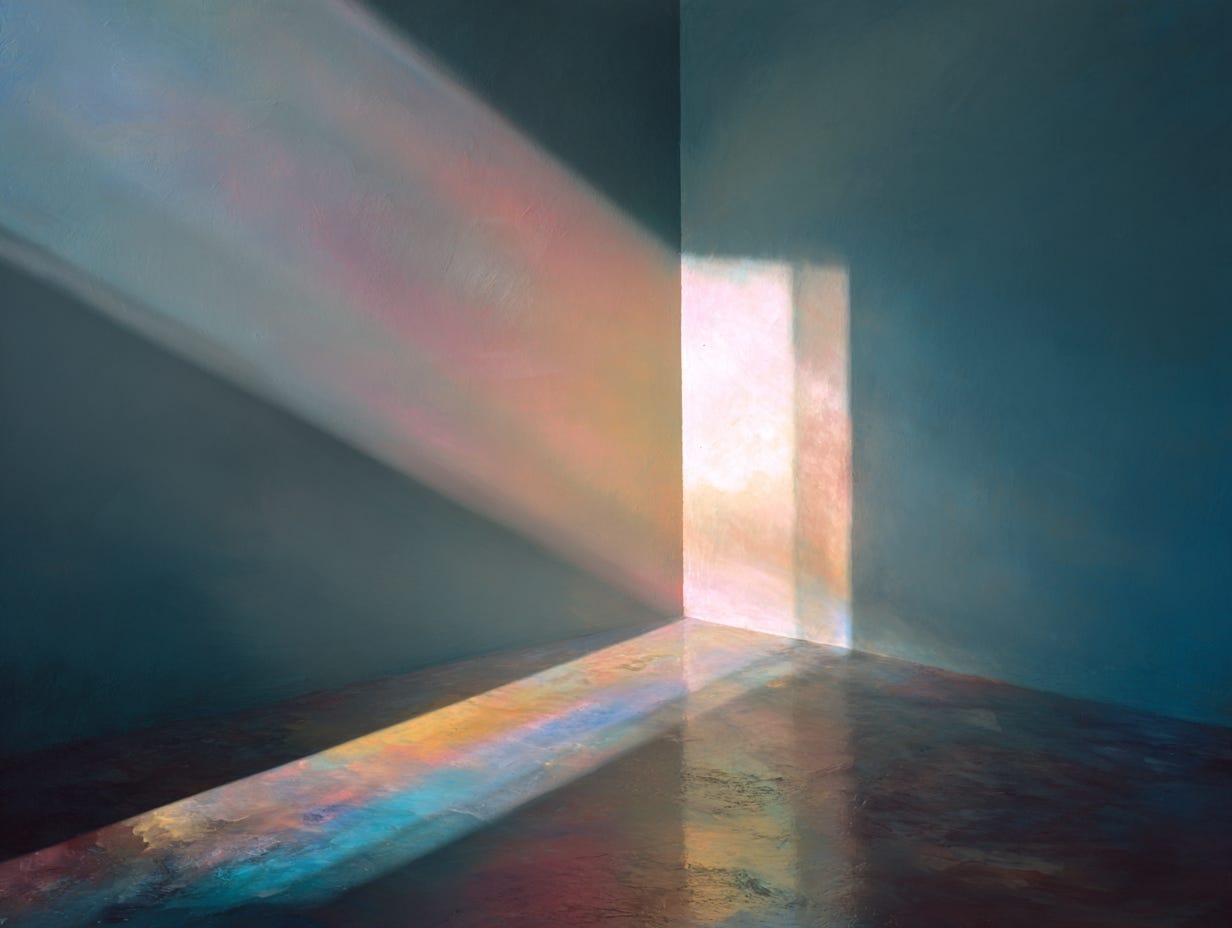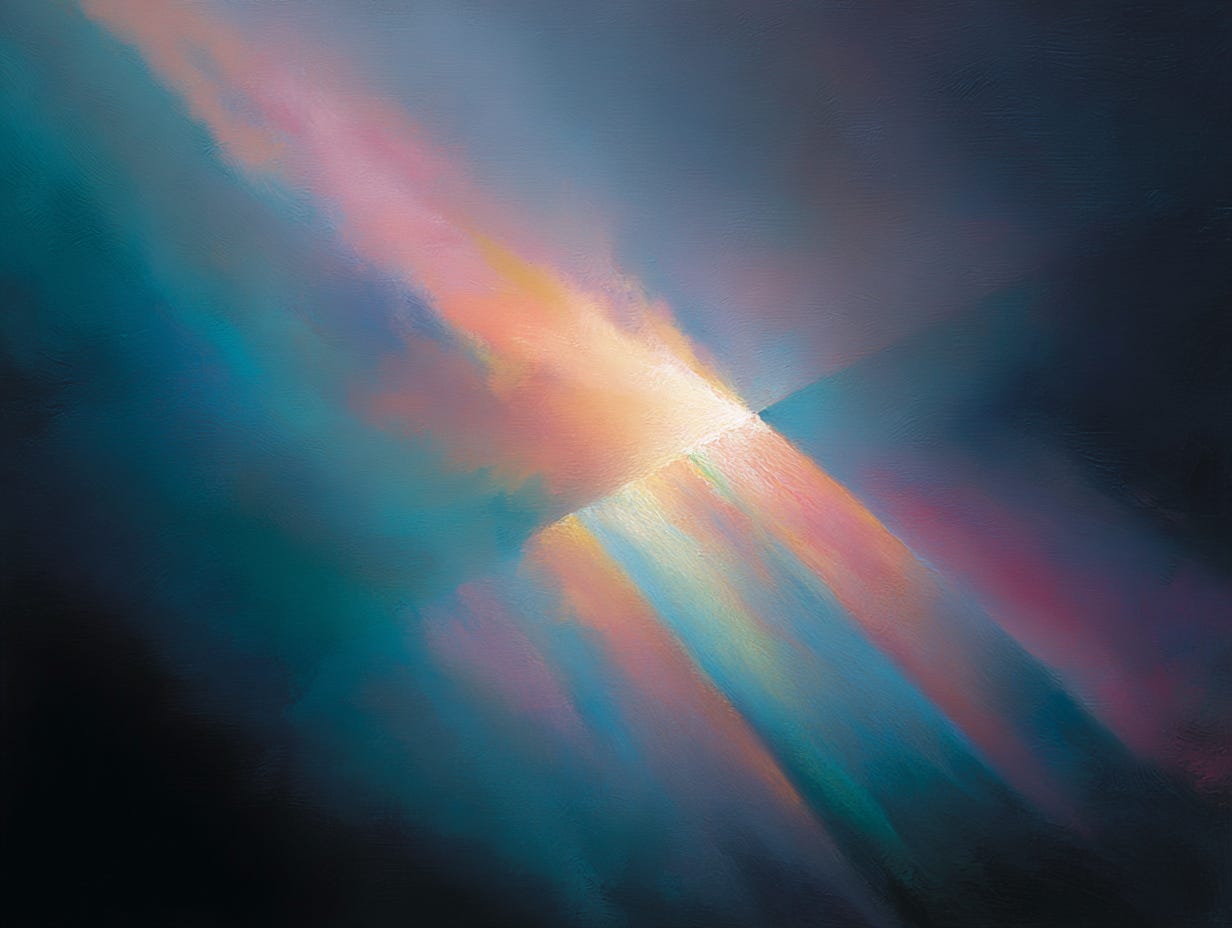The Luminous Thread
On Light, Love, and Service Across Wisdom Traditions
Light has woven itself through the fabric of human consciousness since our earliest stirrings of awareness. From the primordial narratives that anchor our spiritual traditions, including the divine utterance of "Let there be light" in Genesis, the emergence of Brahma from darkness in the Rigveda, and the first dawn breaking over chaos in countless creation myths, to the quotidian rhythms that govern our circadian lives, we are creatures fundamentally oriented by luminosity and its absence.
Consider how light choreographs our days: the subtle shift in quality as morning breaks, the harsh noon glare that sends us reaching for shade, the golden hour that photographers chase, the gradual dimming that signals rest. We adjust constantly with a tilted hat brim, squinted eyes behind sunglasses, and the unconscious drift toward a sunny patch on a cold day. These micro-negotiations with light are so fundamental to our embodied experience that we rarely pause to consider their significance.
The interplay of darkness and light forms one of the essential polarities through which we apprehend reality. Yet to frame this as mere dualism would be to miss the infinite gradations that actually compose our lived experience. Just as no color in nature exists in absolute purity, with the sky's blue shifting from cerulean to cobalt to midnight and a rose containing multitudes of reds, so too does light itself exist on a spectrum of intensity, quality, and meaning. The Sufis speak of the nur, the divine light that has countless veils; each veil simultaneously concealing and revealing different aspects of truth.
This nuanced understanding appears across wisdom traditions. In the Zoroastrian concept of ushta, that luminous happiness that comes from right action, light becomes not just a physical phenomenon but a moral and spiritual orientation. The Jewish mystical tradition of Kabbalah describes the Ohr Ein Sof, the infinite light that had to contract itself through tzimtzum to create space for existence, teaching that even divine light must know limitation to enable creation.
To perceive something in its essential purity, to see past the tints and shades that cloud our ordinary vision, requires what the traditions consistently identify as the lens of love. This is not romantic love or even personal affection, but what the Greeks called agape, the Buddhists term metta, and the Sufis know as ishq-i-haqiqi: love as the fundamental recognition of unity beneath apparent separation.
The Christian mystic Meister Eckhart wrote that,
The eye through which I see God is the same eye through which God sees me.
This collapse of subject and object, seer and seen, occurs when love becomes not just an emotion but an epistemology, a way of knowing. The Hindu tradition captures this in the phrase Tat Tvam Asi (Thou Art That), suggesting that love is ultimately the recognition of the Self in all things, consciousness recognizing itself through infinite forms.
The Lakota phrase Mitákuye Oyásʼiŋ, meaning "all my relations," exemplifies how Indigenous wisdom traditions understand love not as sentiment but as the acknowledgment of our fundamental interdependence. When we see through the eyes of love, we recognize that the light illuminating our path is the same light shining in all beings, refracted through countless forms but never truly divided.
This recognition naturally flows into service, not service as servitude or self-abnegation, but as what the Bhagavad Gita calls karma yoga, the path of action without attachment to results. True service emerges not from obligation but from the overflow of recognizing our shared being. As Rumi wrote,
Let the beauty we love be what we do. There are hundreds of ways to kneel and kiss the ground.
The Buddhist concept of the Bodhisattva, one who vows to forgo personal liberation until all beings are free, represents perhaps the most radical vision of service. It's not merely helping others as separate entities but recognizing that there can be no true freedom while any part of the whole remains bound. The Jewish principle of tikkun olam, repairing the world, similarly frames service not as charity but as participating in the ongoing work of creation itself.
In the Sikh tradition, seva or selfless service is considered as essential as meditation or prayer. The community kitchen called langar, where all eat together regardless of caste, creed, or status, embodies service as a practice that dissolves the very boundaries that create suffering. Ubuntu, the Southern African philosophy summarized as "I am because we are," reframes service from individual action to collective becoming.
What unites these diverse wisdom streams is the understanding that service is not primarily about doing but about being. It's about being so aligned with the fundamental unity of existence that our actions naturally serve the whole. Like light itself, which gives itself completely in each moment without diminishment, authentic service flows from fullness rather than duty.
The mystic traditions remind us that we ourselves are that light, not metaphorically but literally. We are, as Carl Sagan noted, "star stuff contemplating star stuff," beings of light examining our own nature. The photons streaming from distant suns, the bioluminescence of deep-sea creatures, and the firing of neurons in our brains all participate in the same fundamental radiance that spiritual traditions have always intuited.
In our age of artificial illumination, where we can banish material darkness at the flip of a switch, we risk forgetting the teachings that darkness itself offers: the necessity of rest, the invitation to interiority, the reminder that even light needs a backdrop against which to shine. The Muslim practice of tahajjud, the prayer offered in the last third of the night, recognizes that certain insights only emerge in darkness, when the veils between worlds grow thin.
Perhaps this is why so many traditions emphasize the liminal moments of dawn and dusk as especially sacred. These threshold times, when light and darkness mingle without clear demarcation, mirror the spiritual path itself: the gradual brightening of consciousness that never fully leaves the mystery of darkness behind. As we learn to see with the eyes of love and express that vision through service, we discover that we are not seeking light so much as recognizing that we have always been its expression, playing out the eternal dance of revelation and concealment, knowing and unknowing, giving and receiving.
In this recognition lies both the simplicity and the profundity of the spiritual path: to polish the mirror of our hearts until they reflect clearly the light that has always been shining, and to offer that reflection in service to a world that has perhaps temporarily forgotten its own luminous nature. This is not a task to be completed but a way of being to be embodied, moment by moment, breath by breath, one act of love-infused service at a time.
Emergence with Rachel Weissman is a weekly exploration of the interconnections between consciousness, technology, and planetary flourishing.
If you find this writing valuable, leave a heart ❤️, share it with a friend, and consider subscribing if you haven’t already.



